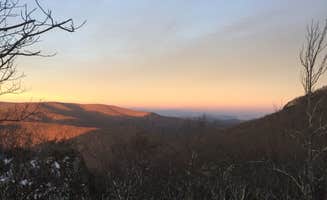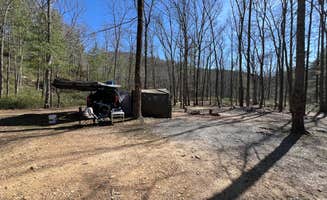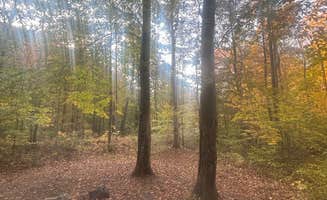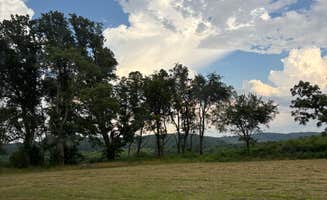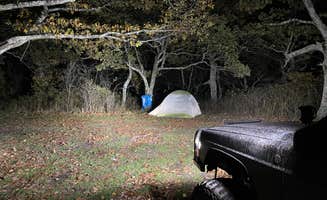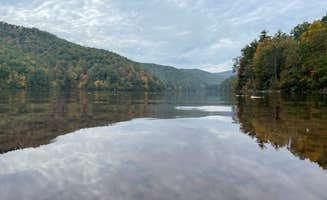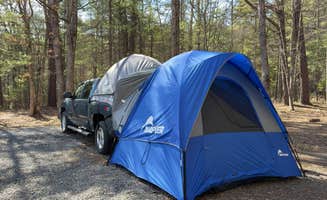Dispersed camping opportunities around Raphine, Virginia extend beyond the George Washington National Forest into multiple recreation areas at varying elevations from 1,200 to 2,800 feet. The terrain features mixed hardwood forests, mountain streams, and elevated ridges accessible via forest service roads. Winter temperatures in this region can drop below freezing from November through March, with summer highs averaging in the mid-80s.
What to do
Hiking to panoramic viewpoints: Spy Rock campsite connects to a popular summit hike with exceptional views. "You hike in and there is a decent sized area to set up tents. Scramble up to the top for amazing sunsets and sunrises," notes one camper at Spy Rock.
Fishing in stocked waters: The ponds and streams offer fishing opportunities throughout the camping season. "The pond is stocked with trout in season, check DGIF site for dates," advises a visitor at Braley Pond Dispersed Camping & Day Use Area.
Exploring forest service roads: Many dispersed sites serve as starting points for off-road adventures. "If you follow the road further, about a quarter of a mile, is another spot for about two or three vehicles," explains a camper at Poor Farm Dispersed Recreation Area.
Creek wading and water exploration: Several campsites feature accessible streams for cooling off. "We picked up and threw away the people's old trash btw. Leave it better than you found it and this awesome site will continue to be fantastic," mentions a visitor describing their creek-side experience at Braley Pond.
What campers like
Solitude and privacy: Campers appreciate the remote nature of many sites near Raphine. "I camped here 3 times, the hike up is brutal but the top is absolutely worth it," explains a reviewer at Spy Rock, highlighting the rewards of more difficult access points.
Stream-adjacent camping: Sites along creeks rank highly among visitor preferences. "Nice camping spot in George Washington NF. There are multiple spots along the road - some are drive in and some require you to park and walk in," shares a camper at George Washington National Forest off 812.
Stargazing opportunities: The limited light pollution creates exceptional night sky viewing. "The stars were amazing! There was plenty of wood scattered about to use as firewood," notes a camper at Braley Pond Dispersed Camping.
Mountain-top experiences: The higher elevation sites provide unique camping settings. "If you want a great view you need to go all the way up to the knob. There are primitive campsites all along the trails," explains a visitor at Flagpole Knob.
What you should know
Vehicle clearance requirements: Many sites demand appropriate vehicles. "Once you turn onto Switzer Lake Rd from U.S. 33 and find the parking area to the lake on your left, be prepared to drive another 2ish miles on a single lane and very bumpy dirt road," cautions a visitor at Switzer Lake Dispersed Camping.
Seasonal accessibility: Weather impacts road conditions significantly. "This area is fairly low, and the road and sites can easily be soaked, if not underwater after really heavy rains," warns a camper about Braley Pond.
Cell service limitations: Connectivity varies by location and carrier. "No cell service(T-Mobile), but if I drove towards the main road, Route 501, I could get some service," reports a camper at Dispersed Camping Site off FR 812.
Wildlife precautions: Bears frequent many camping areas. "There are bears here, so lock up your food in the car. We have encountered a bear at or around the campsite 3 times," shares a camper at Switzer Lake.
Tips for camping with families
Accessible spots for kids: Some areas offer more family-friendly features. "I brought my boys out to camp this past weekend, and this place was perfect for our first dispersed campsite experience," shares a visitor at Dispersed Camping Site off FR 812.
Wildlife viewing opportunities: Natural areas around Raphine provide educational experiences. "We came for this site specifically but it was already occupied so we kept going down the road. Luckily there were 4-5 additional site & we got one for 3 nights," explains a family who discovered multiple options at George Washington National Forest off 812.
Stream exploration: Children particularly enjoy the accessible water features. "Nice size clearing, plenty of flat space, big stone fire ring (we used our little solo stove) and a great stream that runs right by the site," describes a family camper at Braley Pond.
Preparation for primitive conditions: Families need additional planning for rustic camping. "Car could be parked right next to us on site. Next to a creek, so good sounds and cool environment. Some walking trails. A pit toilet is located at the picnic site," explains a camper detailing the limited amenities at Braley Pond.
Tips from RVers
Parking limitations: Most dispersed sites accommodate smaller vehicles only. "The James River WMA is primarily used by hunters and fishermen throughout the year. However, one of the benefits of this place is that it is also open to dispersed campers!" notes a visitor at James River Wildlife Management Area - Dispersed Camping.
Alternative parking options: Some areas provide unexpected access. "After turning onto Midway Mills Lane from the northern end (route 626), there is a gravel access road about .5 miles down the road that is well-maintained. It almost immediately opens up into an open field where large rigs of any size can fit," explains an RVer at James River WMA.
Forest road navigation: Careful planning prevents access issues. "I drove in my 2018 Ram ProMaster 2500 159 wb campervan up that road. It's absolutely pouring down rain and hail," shares one adventurous van camper who challenged the recommendations at Flagpole Knob.


